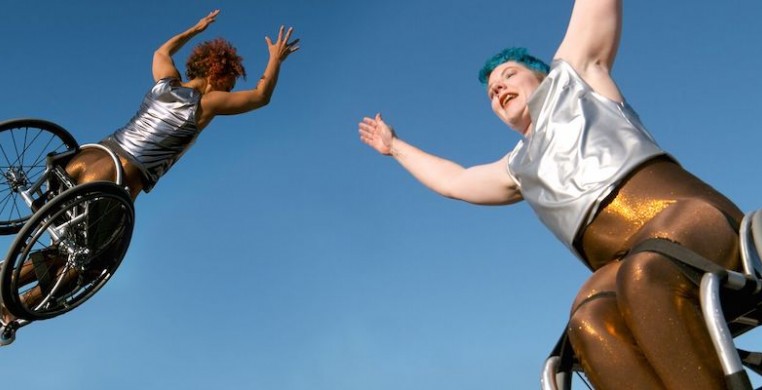UPDATE: The new seechicagodance.com will launch March 31st. Click here to learn more.
JOMBA! USA Dance On Screen depicts intersectional struggle and joy
I tried to shake off my skepticism as I poised to watch the livestream of USA Dance on Screen, which aired Aug. 30 as part of the Digital JOMBA! Contemporary Dance Experience based in Durban, South Africa. I wondered how 10 short dance films presented in one hour could showcase the “varied American experience” as the four curators—Peter Chu, Rachel Miller, Lauren Warnecke, and Tara Aisha Willis—expressed in their curatorial statement. I am cynical about festival categories intended to represent a country, a feeling sharpened by global power disparities exacerbated in a pandemic. How could a group of curators represent the contradictions inherent to the United States today? However, my doubt melted as each film evoked a different facet of humanity’s ability to endure through struggle, and the pain and joy therein.
The first film, “Revel in Your Body,” starred choreographer/dancer Alice Sheppard and co-choreographer/dancer Laurel Lawson of Kinetic Light, a company that performs at the “nexus of access, disability, dance and race.” Directed by Katherine Helen Fisher, the film offers a plurality of identities not often featured in mainstream narratives. “Revel in Your Body” opens on Sheppard’s brown hand holding Lawson’s pale white one as the two spin their wheelchairs around each other, playfully building momentum in a slow-motion shot. The dancers bound into the air in their wheelchairs (designed by Lawson and Paul Schulte) as their faces exalt in the sun. As a non-disabled person, I found myself feeling nervous about the physical risk the dancers took when they launched high into the air. In that moment I realized my woeful lack of experience watching inclusive dance and my bias toward performances with non-disabled dancers because the most triumphant moments were when the dancers soared, suspended mid-flight.
The penultimate film in the series, “Separate Sentences,” directed by Amie Dowling and co-directed and edited by Austin Forbord, explored the prison-industrial complex in the United States. The film follows 19 Black, brown and white male dancers ranging in age, many of whom have been incarcerated or are family members of people who are incarcerated. The dancers clench the weight of mass incarceration’s intergenerational legacy heavy in their limbs as they labor to hold themselves and each other up. The film centers on a young Black boy, Jevon Dyson, who trails after the men to different locations—including Alcatraz Island—casting looks of suspicion, fear and curiosity in turn. The choreography explores many ways the body can lean, against walls, bars and other people, communicating the communal weight of mass incarceration on Black and brown bodies and the vulnerability of receiving support from another human being. The closing scene portrays the men sitting on a hill of rubble lovingly passing Dyson over their heads until he reaches the top. It finishes on a poignant note of hope as the boy climbs into a grassy clearing, moving past the horizon line out of frame.
The Dance on Screen (USA) film selections rendered a nuanced constellation of power imbalances from a variety of perspectives, challenging the audience to lean into the intersectionality of the struggle and to maintain hope for the future.
USA Dance on Screen left me feeling full and a little overwhelmed as I attempted to absorb each film’s approach to issues of representation and perception before the next one began. Fortunately, there’s one more chance to watch it again, screening for a final time on the last day of JOMBA!
--
USA Dance on Screen at the 22nd JOMBA! Contemporary Dance Experience airs on Youtube Live 12 p.m. CST on Sept. 6. To learn more visit www.jomba.ukzn.ac.za.
This piece was produced as part of the inaugural See Chicago Dance Critical Writing Fellowship, in partnership with JOMBA! Contemporary Dance Experience and the University of KwaZulu-Natal (Durban, South Africa), the University of the Witwatersrand and The Ar(t)chive (Johannesburg, South Africa) and the University of East London (London, UK). Financial support is provided by the U.S. Consulate in Durban, the National Endowment for the Arts and the Chicago Department of Cultural Affairs and Special Events.

Fellow Jean Osberger is the assistant director for corporate, foundation, government, & civic relations at the School of the Art Institute of Chicago (SAIC) and a recent graduate of SAIC’s M.A. in arts administration and policy. Her professional work focuses on grant writing, collaborating with community partners, donor stewardship, and programming for events including the annual Citizen Artist Forum. As an arts administrator and a dancer, Jean values the role art can play as a vehicle for community empowerment and the importance of embodied knowledge in everyday life.
Disclosures: SCD editor Lauren Warnecke was a co-curator of USA Dance on Screen

